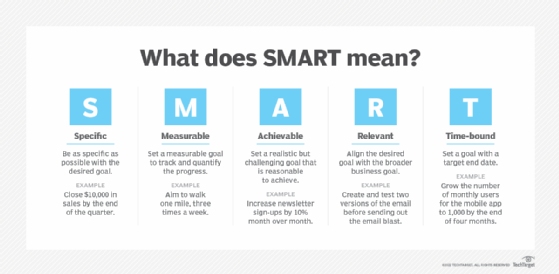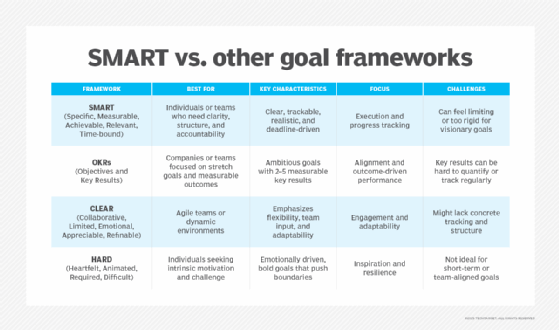What are SMART goals?
SMART is a best practice framework for setting goals that are specific, measurable, achievable, realistic and time-bound. By setting a goal, an individual is making a roadmap for a specific target. Together, the elements in the framework help to create a goal that is carefully and thoughtfully planned, executable and trackable.
The SMART acronym
The SMART goals were first outlined in 1981 by George T. Doran in volume 70, issue 11 of Management Review. In his article, titled "There's a S.M.A.R.T. way to write management's goals and objectives," he described how business goals should have a meaningful effect on an organization by being measurable and achievable.
Often used for performance reviews, the acronym is intended to help a manager or other employee who is tasked with goal setting to clarify exactly what will be required for achieving success and to be able to share that clarification with others. Although it is used in professional settings, SMART goals can be used personally as well. For example, an individual in a small business could set a goal to have better and more efficient communication methods, outlining a realistic and achievable target and time frame.
The SMART acronym has been tweaked over time and continues to vary depending on the person or business using it. At present, the SMART acronym refers to the following:
- S. Specific refers to being as specific as possible with the desired goal. Generally, the narrower and more specific a goal is, the clearer the steps to achieving it will be.
- M. Measurable refers to ensuring there will be evidence that can be tracked to monitor progress.
- A. Achievable refers to ensuring the goal is realistic and possible to complete or maintain within the set time frame.
- R. Relevant refers to making sure the goal itself aligns with values and long-term goals and objectives.
- T. Time-bound refers to making sure the goal is set within an appropriate time frame.

Benefits of SMART goals
SMART goals provide numerous opportunities for both personal and business success and can help achieve short-term and long-term objectives.
The following is a list of benefits that individuals and businesses can realize by incorporating the SMART mnemonic into their management-by-objectives philosophy:
- Focus and direction. SMART goals break down broader goals into specific and actionable objectives, thus providing a sense of direction and focus on the desired result.
- Evaluation of strengths and weaknesses. While setting up objectives, people can establish benchmarks and evaluate their strengths and weaknesses.
- Motivation to succeed. Once the goals are laid out, most people will want to work hard to achieve them. For example, a company that wants to increase sales can set up an employee incentive program that will propel employees into reaching certain milestones.
- Taking action. SMART goals are attainable but also challenging. Their challenging aspects automatically force people out of their comfort zones and into action.
- Faster results. When following SMART goals and objectives, people waste less time doing irrelevant tasks and spend more time delivering the results.
- Identification of potential problems. SMART is a performance-enhancer tool, as it can identify areas that require improvement. For example, a student using this framework can determine if their timeline to study for a test is realistic.
- Sense of satisfaction. SMART goals can provide a feeling of satisfaction as people continue to monitor their progress.
Creating SMART goals
SMART goals can provide momentum toward both personal and professional objectives. By using the SMART framework, goal owners can keep track of time, hold themselves accountable and consistently track progress toward their ultimate goal.
The following is a breakdown of each SMART goal and how it can be crafted:
1. Specific
Being specific means there is no ambiguity surrounding the end goal. While it does not provide a detailed list of how the individual will achieve the goal, it eradicates the vagueness in terms of what they want to achieve.
To create specific goals, it is important to answer the following questions:
- Who needs to be involved to achieve the goal?
- What is the individual trying to accomplish?
- Where is the goal located?
- Why is the goal important?
- Which resources or obstacles are involved in achieving the goal?
- When should the goal be achieved?
2. Measurable
A goal should be measurable, which means the person should be able to track and quantify the goal's progress. This helps the goal maker stay focused and on track for reaching deadlines.
A measurable goal should be created by answering the following questions:
- How much?
- How many?
- What are the indicators of progress?
- How will the goal setter know when the goal is reached?
3. Achievable
To achieve goals, those goals should be realistic. Depending on how important the end goal is, the individual might need to develop new skills and attitudes. While a realistic goal should amplify that person's abilities, it also should remain doable and inspire motivation. For example, setting a goal of running a marathon in under three hours would be impossible for most people.
When setting an achievable goal, the following points should be considered:
- How can the individual reach the goal?
- How realistic is the goal?
- Are the necessary tools and skills available?
- What would it take to attain the goal?
- Which tools and skills will be required to achieve the goal?
4. Relevant
A goal should align with a broader business goal and must be appropriate to what that person is trying to accomplish.
A relevant goal should answer the following questions in the affirmative:
- Does the goal seem worthy?
- Does it reflect other efforts and needs?
- Is it the right time to carry out the goal?
- Is the assigned person the right one to carry out this goal?
- Is this an appropriate goal for the current social and economic environment?
5. Time-bound
Finally, a goal should have a time period or a target end date. If the goal is expansive, it could be broken down into smaller, more manageable chunks. Setting up a realistic end date can create a sense of urgency, which can be beneficial in achieving the goal.
When setting a time frame for a goal, the following questions should be answered:
- When will the goal be achieved?
- What can be done six months from now?
- What can be achieved six weeks from now?
- What can be accomplished today?
SMART goal examples
Each element of the SMART framework plays a vital role in defining objectives to mapping out a clear plan for achieving those objectives.
The following are a few practical applications and examples of SMART goals:
- Increasing web traffic to the company's homepage by 20% in the next 60 days.
- Aiming to walk one mile, three times a week
- Writing 3,000 words per week.
- Increasing 401(k) contribution by 1% after each raise.
SMART vs. other goal frameworks
While SMART goals are widely used across industries for setting clear, actionable objectives, they're not the only framework available. Depending on the organization's overall goals, leadership style, or personal preference, other models -- detailed in the following table -- like OKRs, CLEAR, and HARD goals might be more suitable.
Understanding how the SMART goals concept compares to these frameworks can help individuals and teams choose the method that best aligns with their needs -- whether those needs are clarity, ambition, agility, or emotional investment.
Here's a side-by-side comparison of how SMART goals differ from other popular goal-setting approaches:

Which framework should you use?
Each framework has its strengths. In some cases, a hybrid approach may be the most effective. For example, that could mean using SMART goals to support broader OKRs. Here's a quick breakdown to help you choose:
- Choose SMART goals when you need structure, predictability, and accountability, especially for short- to mid-term objectives.
- Use OKRs when your organization is scaling, aligning cross-functional teams, or pursuing bold growth targets.
- Consider CLEAR goals for fast-moving teams that need to remain adaptable and motivated in collaborative settings.
- Try HARD goals when you want to push yourself beyond limits and achieve something personally meaningful.
Using digital tools to track SMART goals
Many individuals and teams now use digital platforms to manage their goals effectively. Tools like Trello, Notion, Google Workspace, Asana, and ClickUp are popular for tracking goal progress, setting deadlines, and collaborating with team members. These platforms make it easy to create, monitor, and adjust SMART goals in real time.
As with any approach to creating and tracking agreed-upon goals, individuals and managers must be ready to adjust individual goals over time to reflect unexpected changes in areas such as organizational processes and changes in an individual's responsibilities.
SMART goal FAQs
The following are some of the most common questions asked about SMART goals.
- What does SMART stand for in goal setting?
SMART stands for specific, measurable, achievable, relevant, and time-bound. - Are SMART goals still used today?
Yes. SMART goals remain one of the most popular and effective frameworks for setting personal and professional goals. - Can SMART goals be used outside of work?
Absolutely. SMART goals are effective for personal development, fitness, finances, and education -- anywhere goal-setting is needed. - What tools can help track SMART goals?
Apps like Trello, Notion, Asana, and Google Sheets can help individuals and teams stay organized and track SMART goals effectively.
Similar in concept to the SMART goals, a business process management (BPM) approach enables companies to continuously improve and renovate their business processes. Learn more about the best practices used for setting up successful BPM strategies.